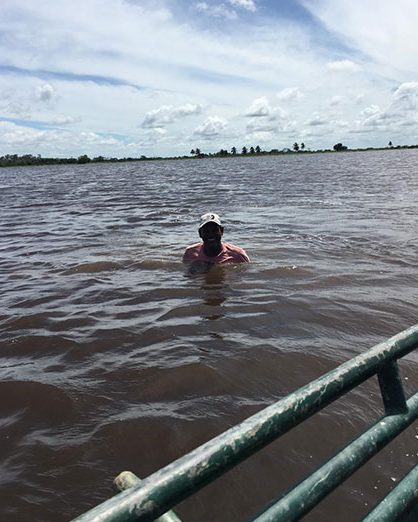– majority of losses occur in Regions 5 and 6
-farmers still forge ahead to replant
EVEN with the ongoing floods, rice farmers are pressing ahead to sow, and in some cases, re-sow for this year’s second rice crop and according to documents provided by Agriculture Minister Zulfikar Mustapha, some 77.64 per cent of rice lands across the country has already been sown.
This represents the initial sowing of approximately 150,673 acres of land; of that figure, 17,919.72 acres of paddy were destroyed, largely owing to the ongoing floods.
Despite the devastation that the floodwaters have caused, rice farmers have still managed to forge ahead, and were able to re-sow some 9,666.31 acres of land. As a result, an adjusted 142,419.72 acres of rice lands were sown.

The figures indicate that all rice-producing regions have suffered losses of paddy, with Region Six, East Berbice-Corentyne leading the list with an estimated loss of 9,807.88 acres of rice lands. The Ancient County is one of the areas most affected by the ongoing floods.
Initially, some 37,753.48 acres were sown, while 6,483 acres were re-sown as a result of the losses. Ultimately, there was an adjustment of 34,428.6 acres to be sown, with 66.47 per cent sown thus far. To this end, the region has a revised target of 51,795.90 acres of rice lands.
Minister Mustapha had reiterated the government’s commitment to partnering with farmers to minimise the effects of the current flood on the country’s second rice crop for 2021. Customarily, the May/June period would see rice farmers across the country engaged in preparing their fields and sowing seeds for harvest in October-November.

Further, the Guyana Rice Development Board (GRDB) had warned against sowing after the recommended period which ended on June 30; however, many farmers have persevered to re-sow. In Region Five, Mahaica-Berbice, where many rice lands remain inundated, farmers have recorded a loss of some 6,367.96 acres of paddy.
A total of 51,586.20 acres were initially sown, while 1,630.93 acres had to be re-sown. Many farmers in the Mahaica/Mahaicony area have chosen not to participate in the current crop. As a result, only 67.81 per cent of paddy was sown, with an adjustment of 46,849.17 acres and a revised target of 69,090.84 acres.
Minister Mustapha had previously indicated that even though many rice lands are facing the threat of being flooded, only a small amount of the current rice crop has been damaged.
He said that Extension Officers from the Ministry of Agriculture and the GRDB have been mandated to work with all rice farmers to minimise damage and safeguard the rice being planted.
In the regions minimally affected by the floods, sowing has been recorded in the 90 percentiles. More specifically, Region Four, Demerara-Mahaica has seen 93.26 per cent of rice lands already sown, while sowing in Region Three, Essequibo Islands-West Demerara, has reached 97.63 per cent.
From all indications, Region Two (Pomeroon-Supenaam) has been leading the targets with 98.95 per cent of all rice lands already sown. Moreover, of the 253 acres of paddy that were lost, all were re-sown. Consequently, the adjusted sowing stands at 34,444.53 acres, in pursuit of a revised target of 34,809.71 acres.
Minister Mustapha had said that even though the majority of this rice crop has been saved, authorities will still have to wait until the harvest to determine the success of this second crop. Notwithstanding the challenges, Guyana’s rice industry continues to be one of the leading local income earners, raking in some US$123,023,868 (G$25.7 billion) from the export of paddy, rice and rice by-products between January and June 2021.
During this period, some 280,878 tonnes of paddy were produced, representing an improvement in production when compared to the corresponding period last year, that period saw the exportation of 242,000 tonnes of paddy, rice and rice by-products, which earned US$99 million.
General Manager of the GRDB, Kuldip Ragnauth, had previously told the Guyana Chronicle that some 98 per cent of the year’s first crop has already been harvested, while a small amount remained in the fields and suffered damage due to the ongoing floods.
Minister Mustapha had indicated that since the unprecedented floods started in May, the Ministry of Agriculture and all of its agencies, including the GRDB and the National Drainage and Irrigation Authority (NDIA) have been working around the clock to reduce the effects of the floods on all Guyanese, especially those who rely on farming for their livelihoods.
As it is, all agencies have been tasked with executing daily monitoring and providing constant updates. “It’s a work in progress,” Mustapha acknowledged.
In addition to providing tangible relief, the government has also moved to ensure that farmers have shoulders to lean on in their time of distress. To this end, Extension Officers attached to the National Agricultural Research and Extension institute (NAREI), were trained to provide some amount of psychological support to distraught farmers and their families.
According to Pooran Seeraj, Head of NAREI’s Extension Services, the agency has recognised the impact of the floods on more than just crops and livelihoods; he said that farmers have begun to rely on agricultural extension officers for hope and courage to persevere.
Added to that, the government has also initiated conversations with various banking and financial institutions to ensure that humanitarian relief is given to the farmers.
During a previous interview, Senior Minister in the Office of the President with responsibility for Finance, Dr. Ashni Singh had said that even though the entities are yet to definitively say how they are going to assist, all the institutions are cognisant of the devastation that the floods have brought, and are committed to assisting in government’s recovery efforts.



.jpg)









